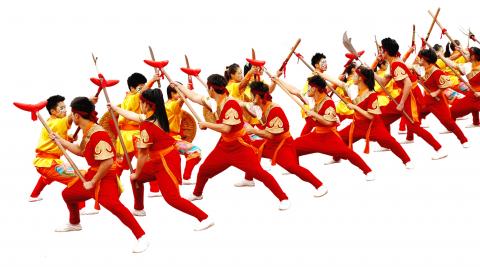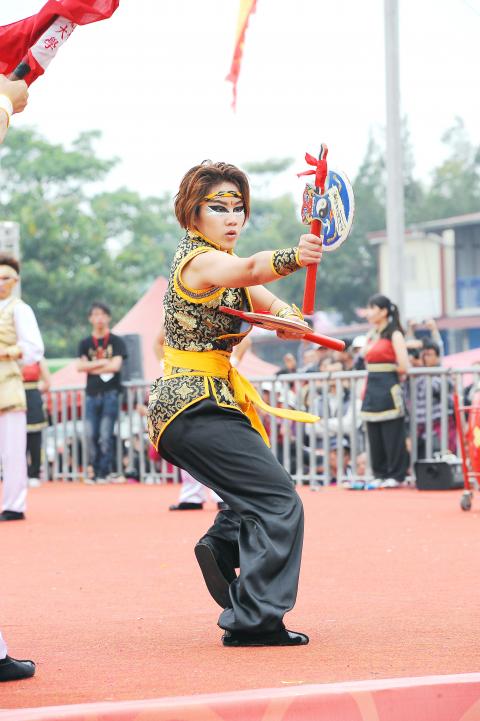This weekend, thousands of martial arts fans are expected to descend on Greater Kaohsiung’s Neimen District (內門) to watch a week-long lineup of Song-Jiang Jhen Battle Array (宋江陣), a form of performing arts that combines elements of kung fu, dance and drumming.
The festival, now in its 12th year, invites martial arts troupes from home and abroad to showcase their best moves. Groups of college students will also take part in a creative competition, which is aimed at revitalizing the tradition.
Originating over a century ago, the battle array was named after Song Jiang (宋江), leader of a group of bandits who lived during the Song Dynasty. In training his henchmen, Song would divide them into two groups and have each person carry a weapon. A round of mock duels would then follow.

Photos Courtesy of Kaohsiung City Government
The method was so successful in preparing the men for battle, it was later adopted as a regular military exercise to boost defense capability and ward off pirates, bandits and neighboring clans. A wide variety of weapons, strategies, formations and music were applied to make the exercise more challenging.
Over the years, the battle array has transformed itself into a ritual that is performed in temples to honor the birthdays of deities. Today, temples in southern Taiwan organize the performance teams themselves. Although a full-size team consists of 107 members, it is more common to see a 72 or 36-member array.
Recognizing that the custom has been slowly dying out, the Kaohsiung City Government, in cooperation with local temples, has been holding a series of activities in Neimen to revive interest in the performance art.

Photos Courtesy of Kaohsiung City Government
“Neimen is a special place … Its population stands at 15,000, but it has 50 to 60 martial arts performance troupes,” said Deputy Mayor Lee Yung-te (李永得) at a press conference held to launch the annual festival.
Many uprisings took place in Neimen in the past, including a large scale anti-Manchu protest led by Chu Yi-kuei (朱一貴) in the early 18th century. Neimen people’s valor and courage both in the past and present contributed greatly to Taiwan’s battle array culture, he said.
Introducing the battle array as an art that integrates sports and music, Lee said that the event is a great way to experience Taiwan’s rich cultural heritage. Photo exhibitions, calligraphy shows and a culinary extravaganza will also be held alongside the performances. Complete details in Chinese and English can be found at: www.who-ha.com.tw.

In Taiwan there are two economies: the shiny high tech export economy epitomized by Taiwan Semiconductor Manufacturing Co (TSMC, 台積電) and its outsized effect on global supply chains, and the domestic economy, driven by construction and powered by flows of gravel, sand and government contracts. The latter supports the former: we can have an economy without TSMC, but we can’t have one without construction. The labor shortage has heavily impacted public construction in Taiwan. For example, the first phase of the MRT Wanda Line in Taipei, originally slated for next year, has been pushed back to 2027. The government

July 22 to July 28 The Love River’s (愛河) four-decade run as the host of Kaohsiung’s annual dragon boat races came to an abrupt end in 1971 — the once pristine waterway had become too polluted. The 1970 event was infamous for the putrid stench permeating the air, exacerbated by contestants splashing water and sludge onto the shore and even the onlookers. The relocation of the festivities officially marked the “death” of the river, whose condition had rapidly deteriorated during the previous decade. The myriad factories upstream were only partly to blame; as Kaohsiung’s population boomed in the 1960s, all household

Allegations of corruption against three heavyweight politicians from the three major parties are big in the news now. On Wednesday, prosecutors indicted Hsinchu County Commissioner Yang Wen-ke (楊文科) of the Chinese Nationalist Party (KMT), a judgment is expected this week in the case involving Hsinchu Mayor Ann Kao (高虹安) of the Taiwan People’s Party (TPP) and former deputy premier and Taoyuan Mayor Cheng Wen-tsan (鄭文燦) of the Democratic Progressive Party (DPP) is being held incommunicado in prison. Unlike the other two cases, Cheng’s case has generated considerable speculation, rumors, suspicions and conspiracy theories from both the pan-blue and pan-green camps.

Stepping inside Waley Art (水谷藝術) in Taipei’s historic Wanhua District (萬華區) one leaves the motorcycle growl and air-conditioner purr of the street and enters a very different sonic realm. Speakers hiss, machines whir and objects chime from all five floors of the shophouse-turned- contemporary art gallery (including the basement). “It’s a bit of a metaphor, the stacking of gallery floors is like the layering of sounds,” observes Australian conceptual artist Samuel Beilby, whose audio installation HZ & Machinic Paragenesis occupies the ground floor of the gallery space. He’s not wrong. Put ‘em in a Box (我們把它都裝在一個盒子裡), which runs until Aug. 18, invites